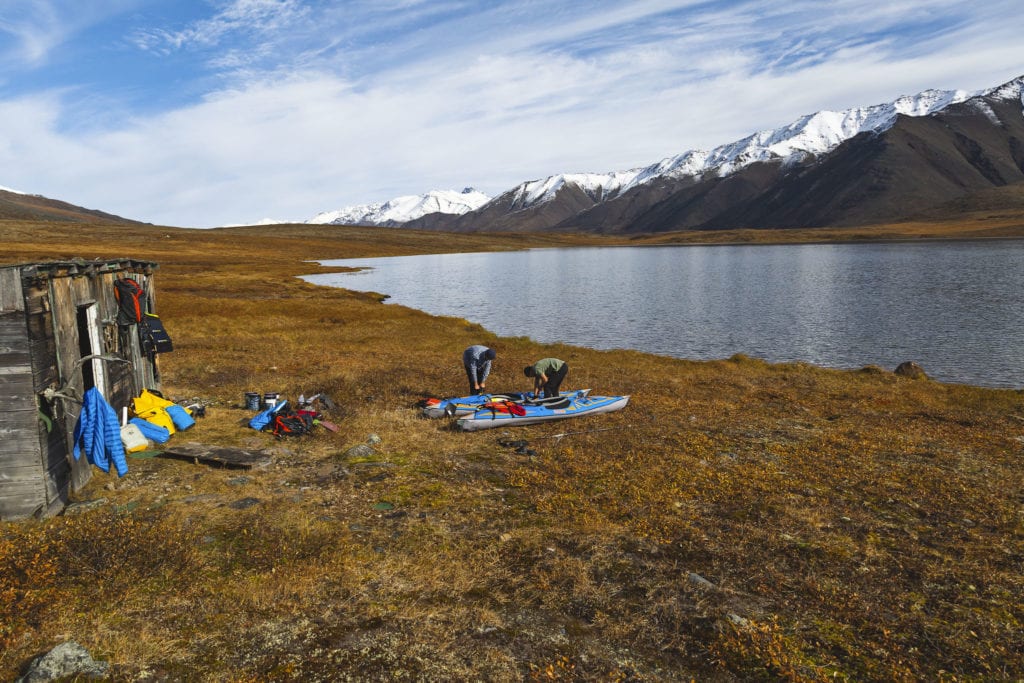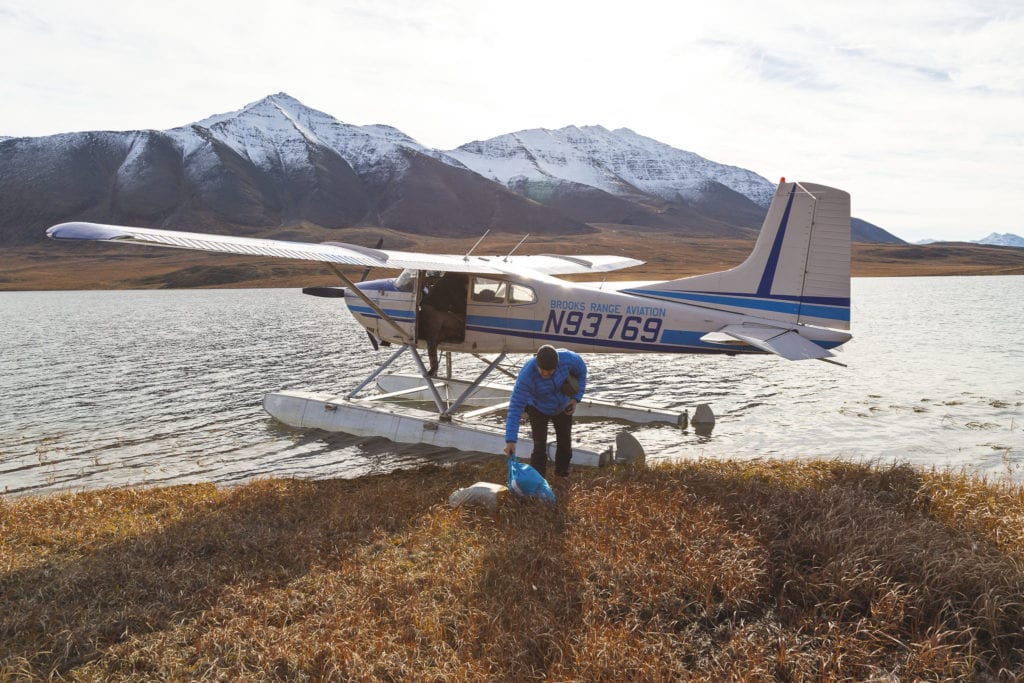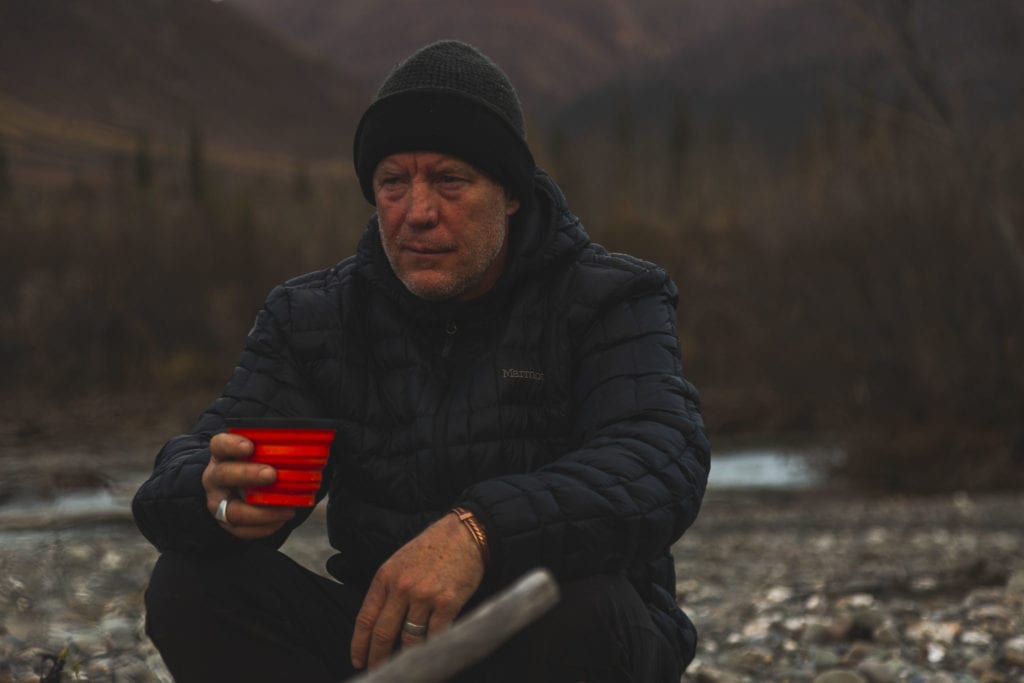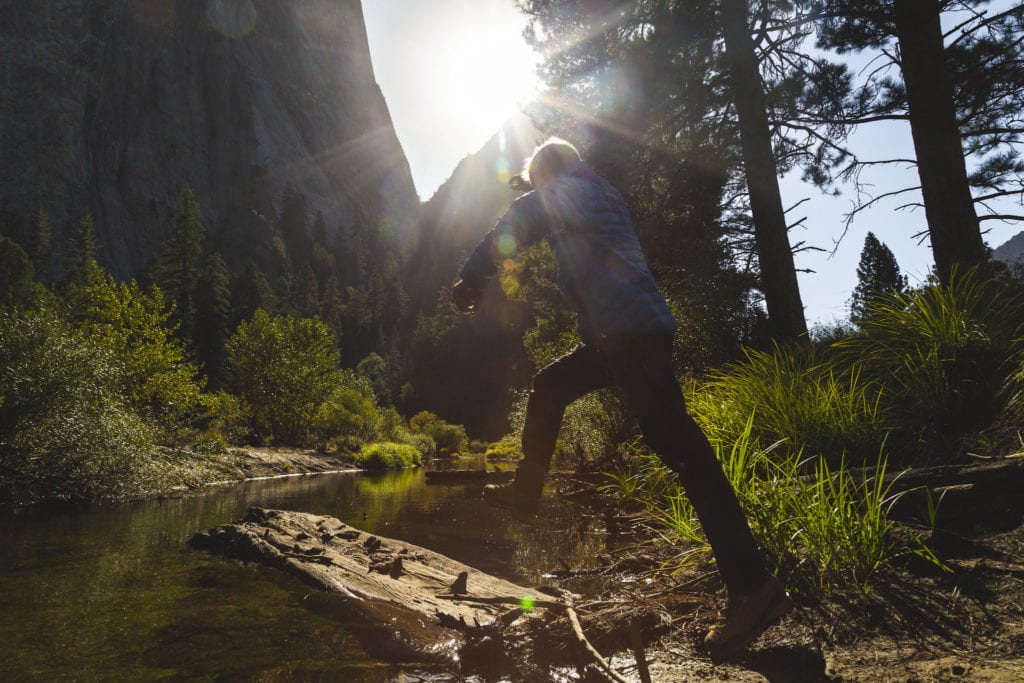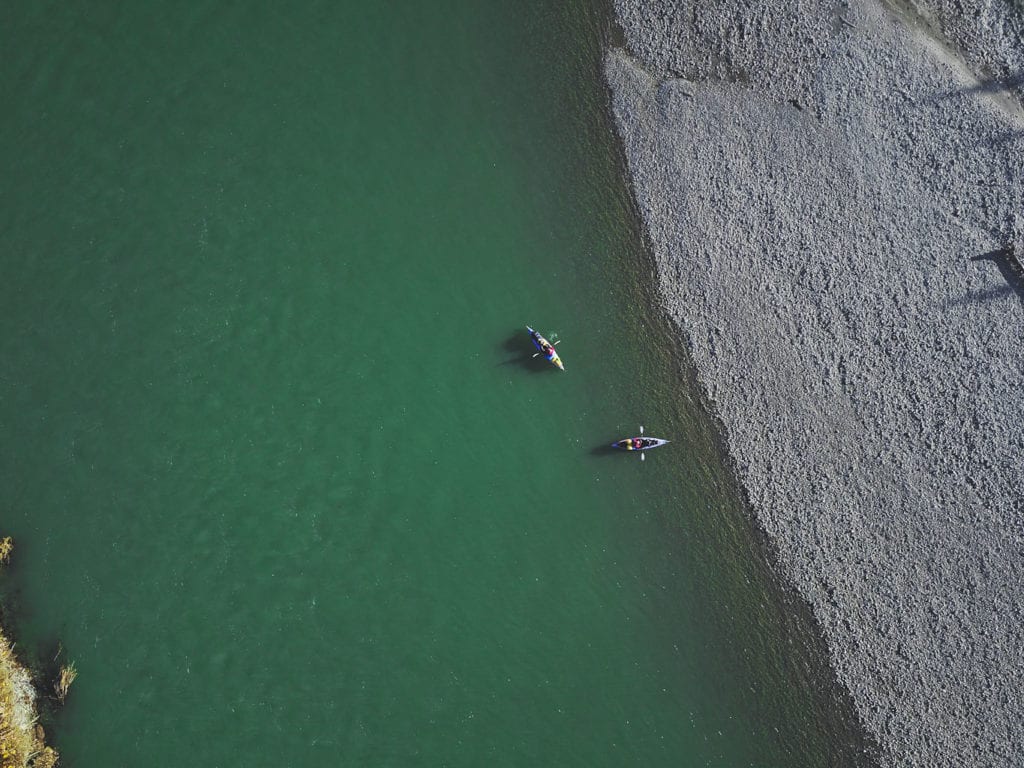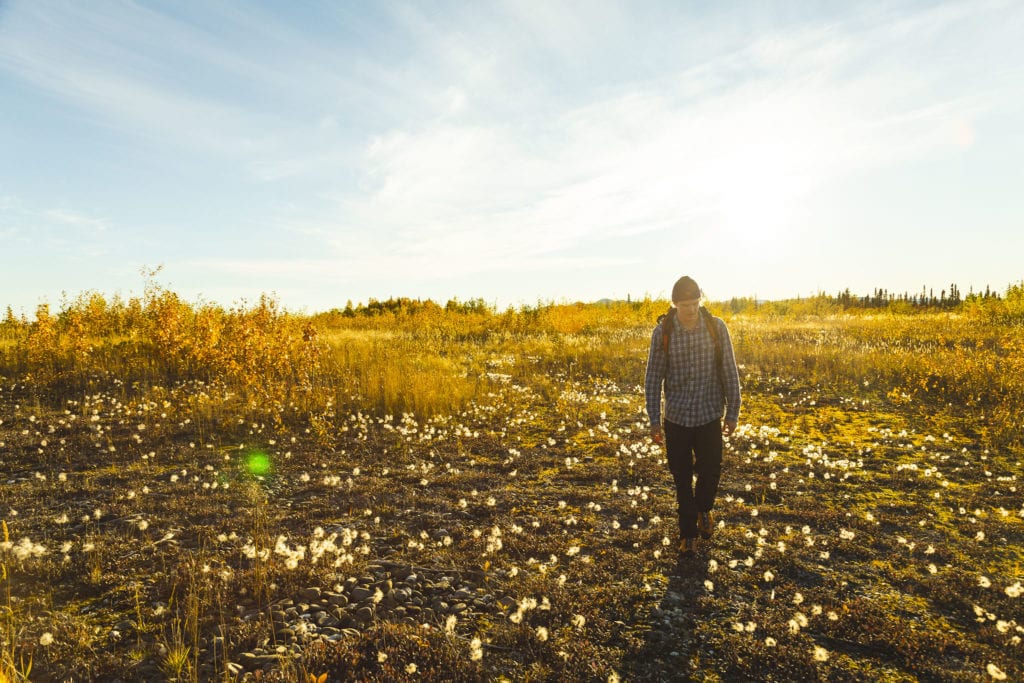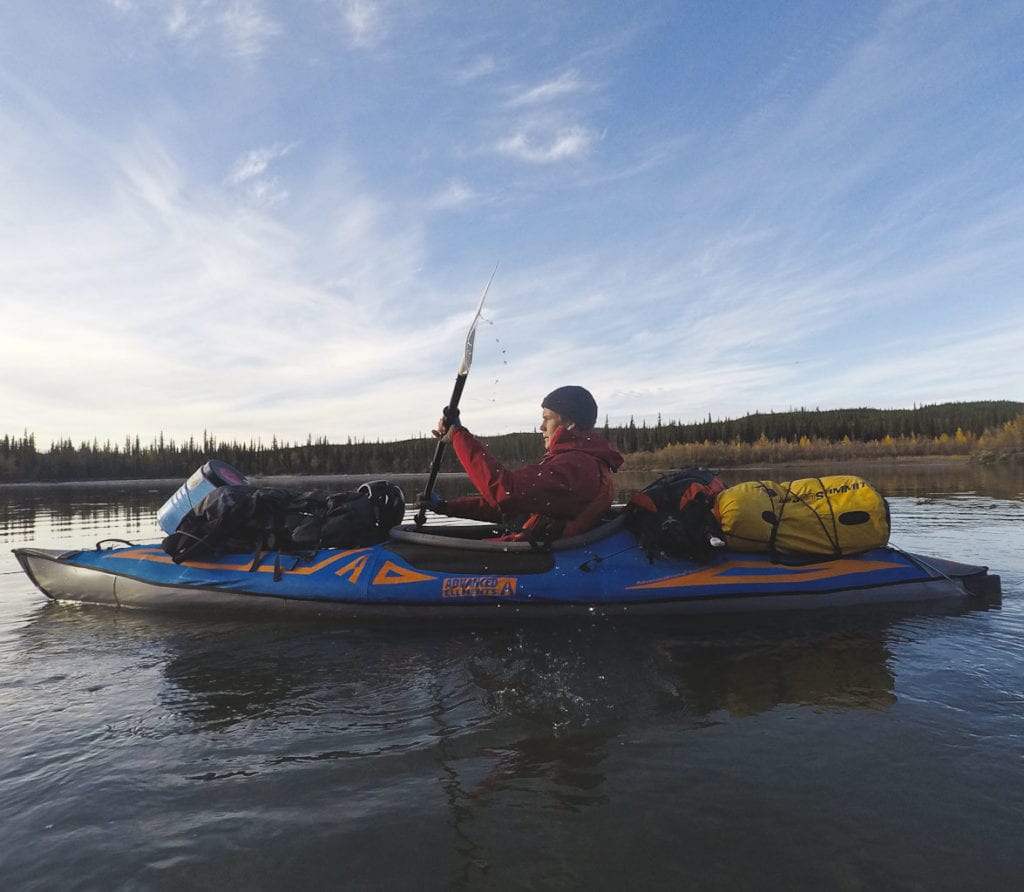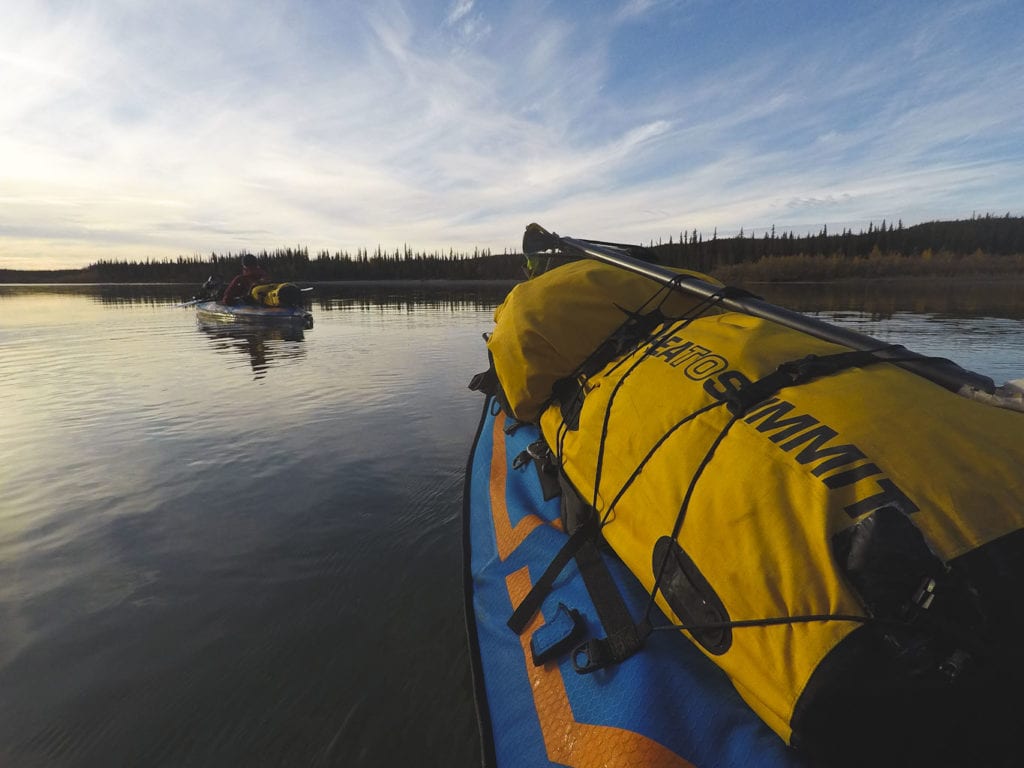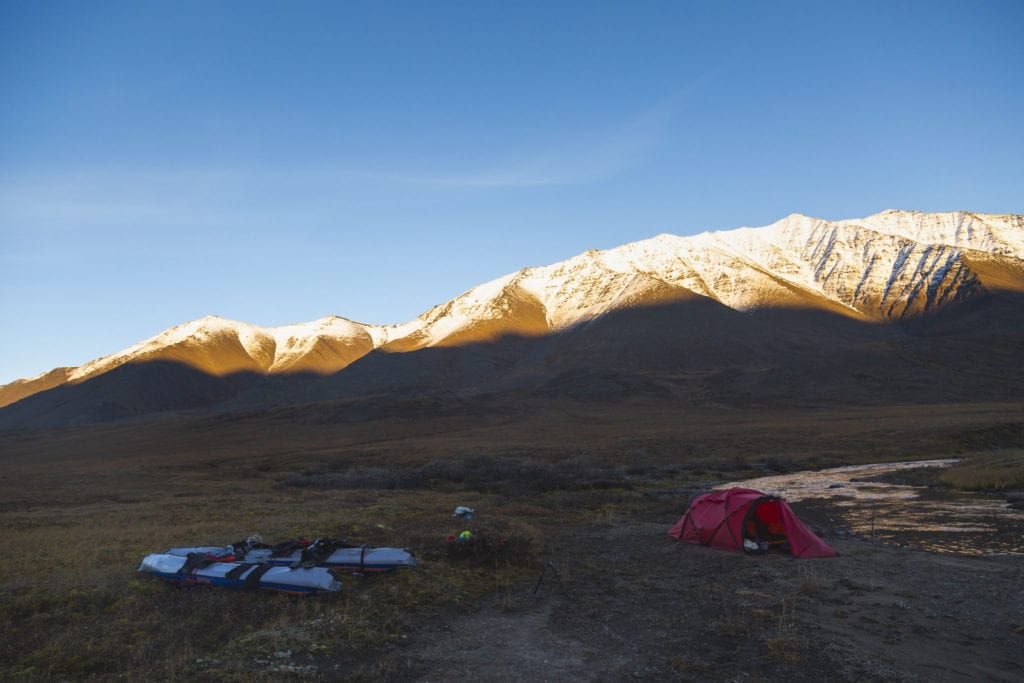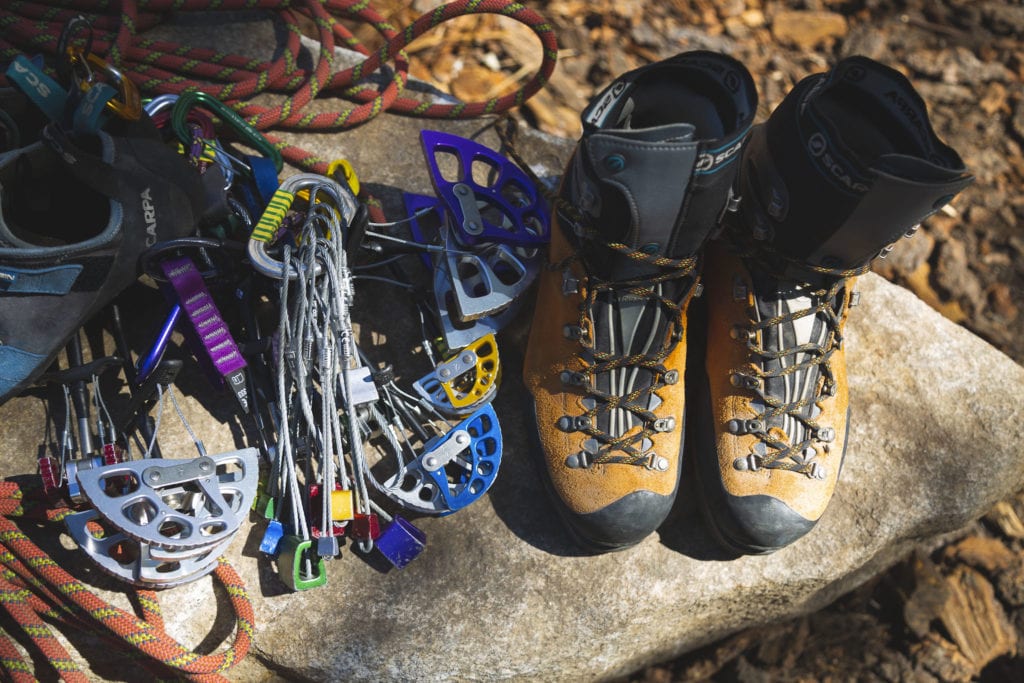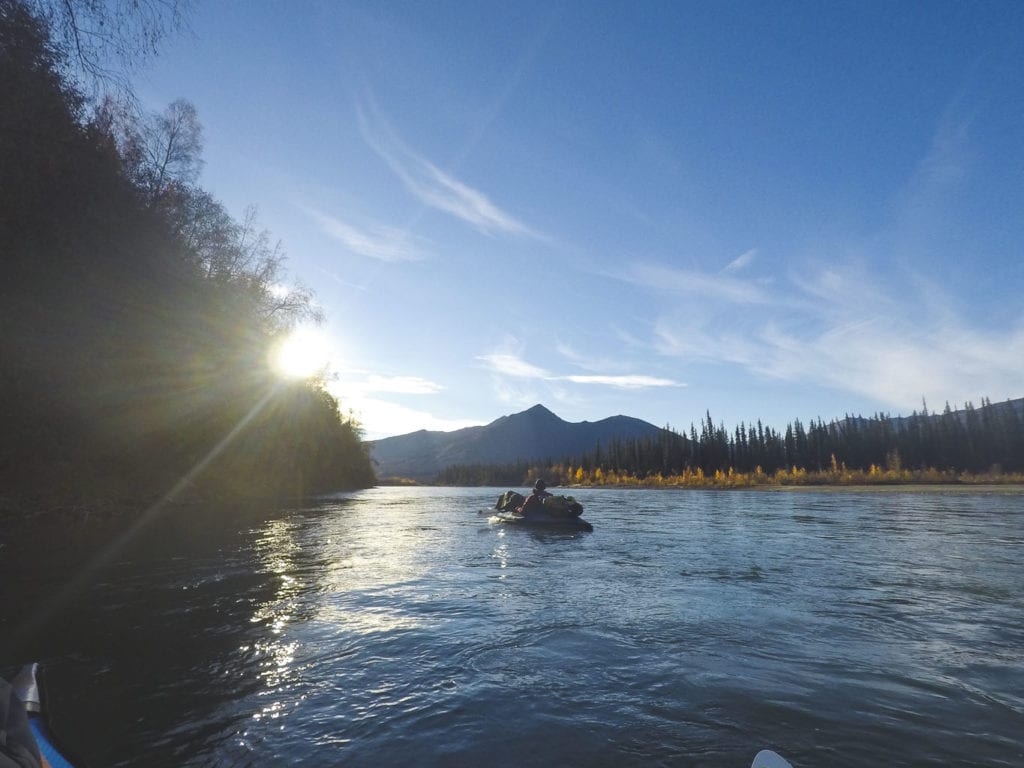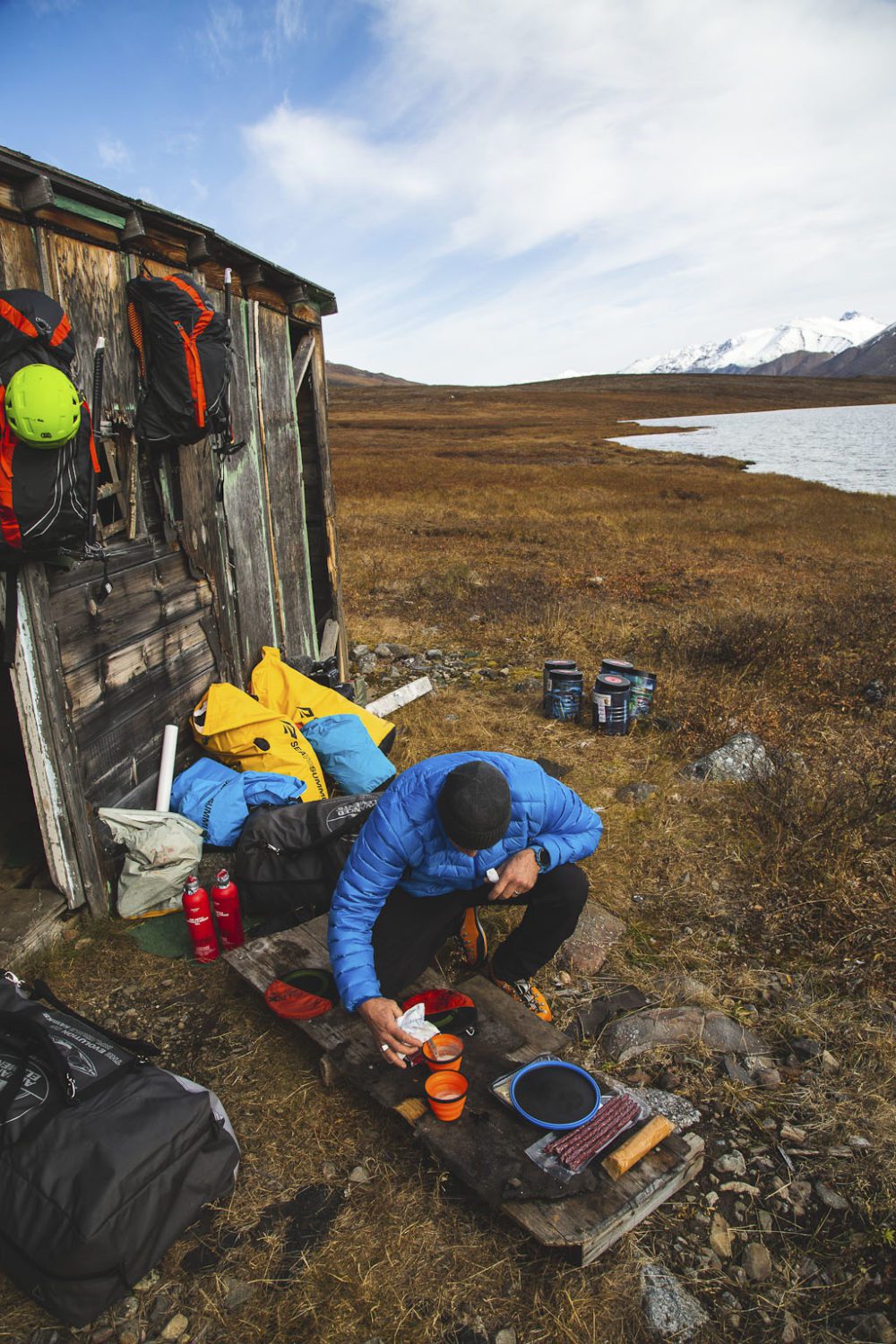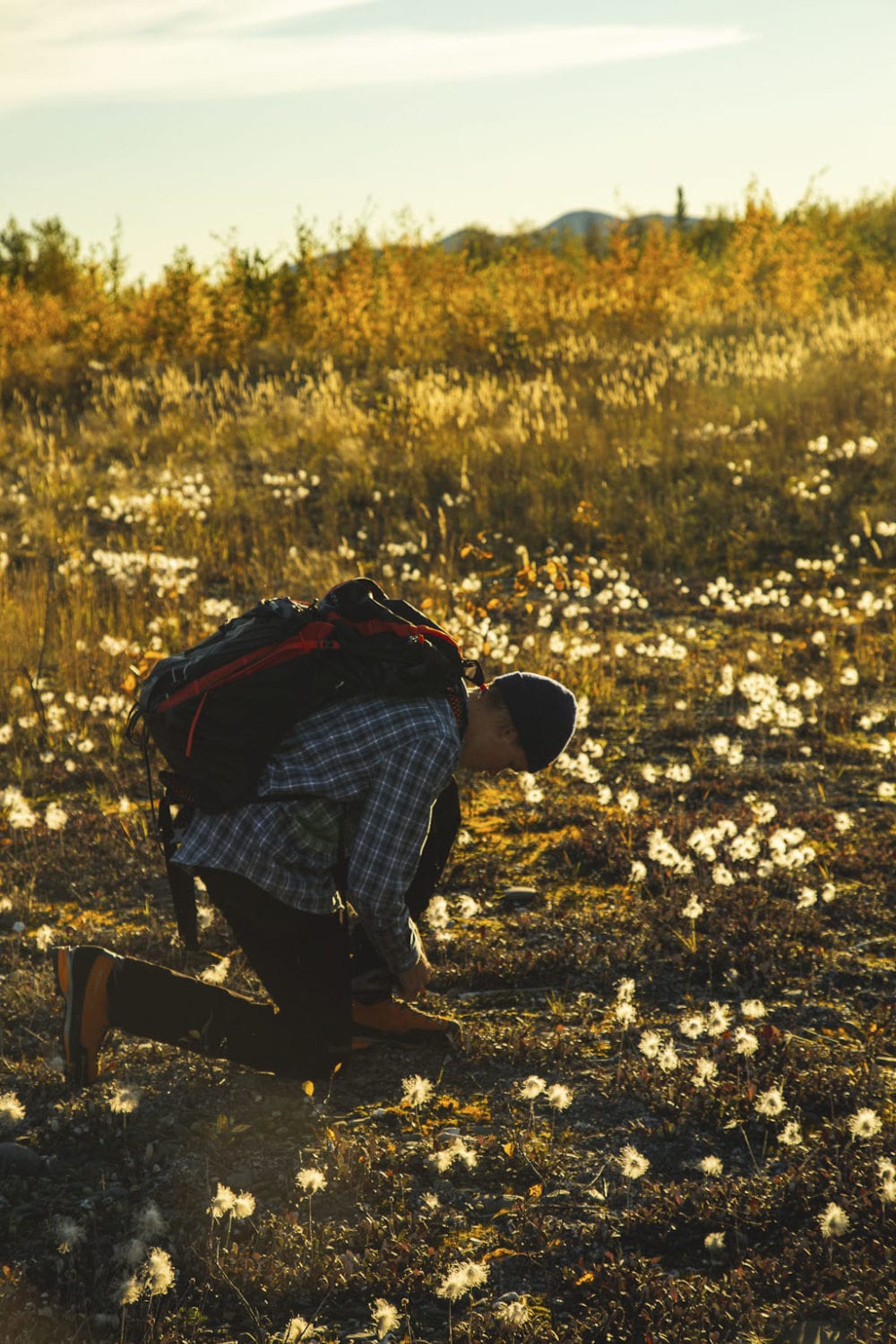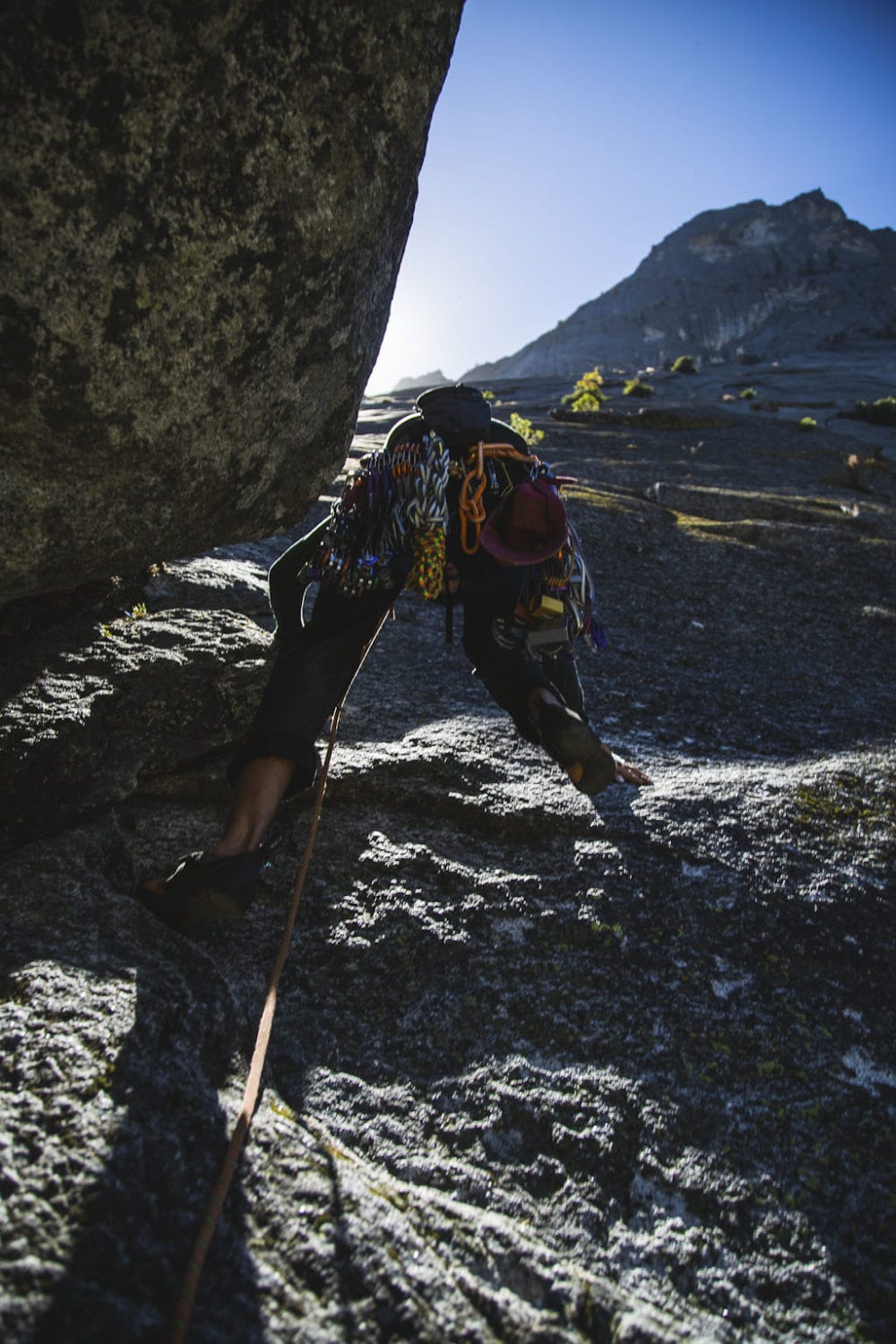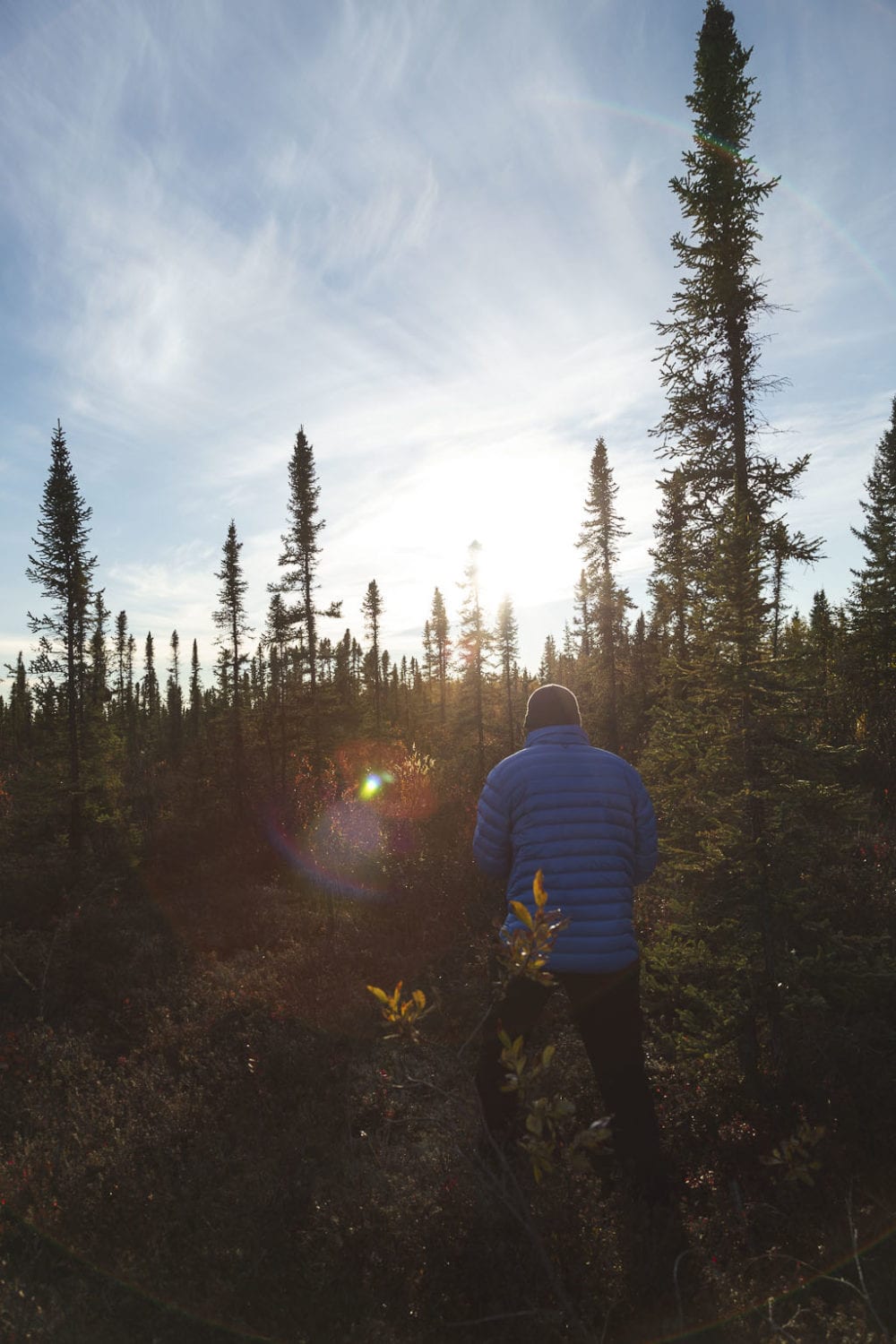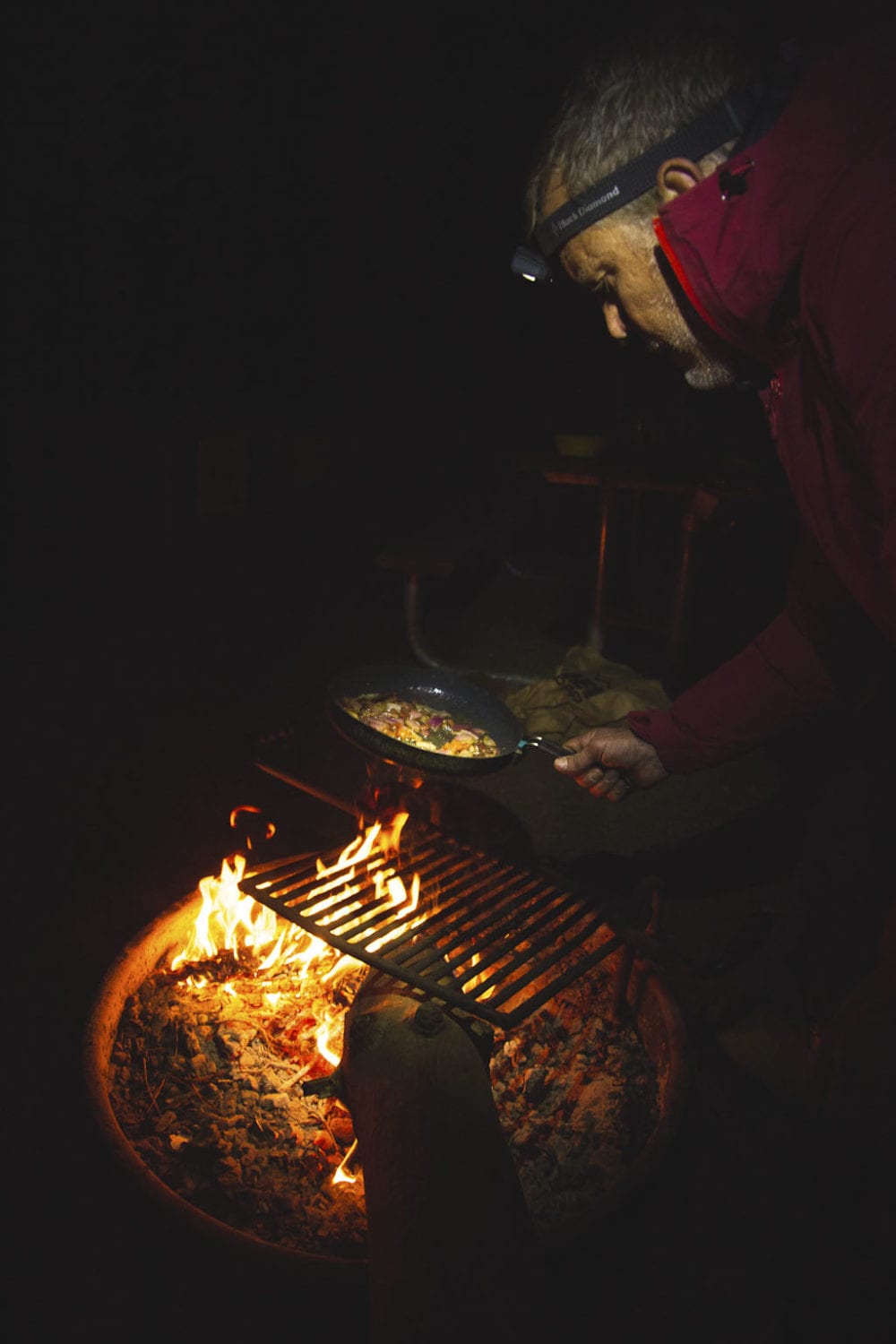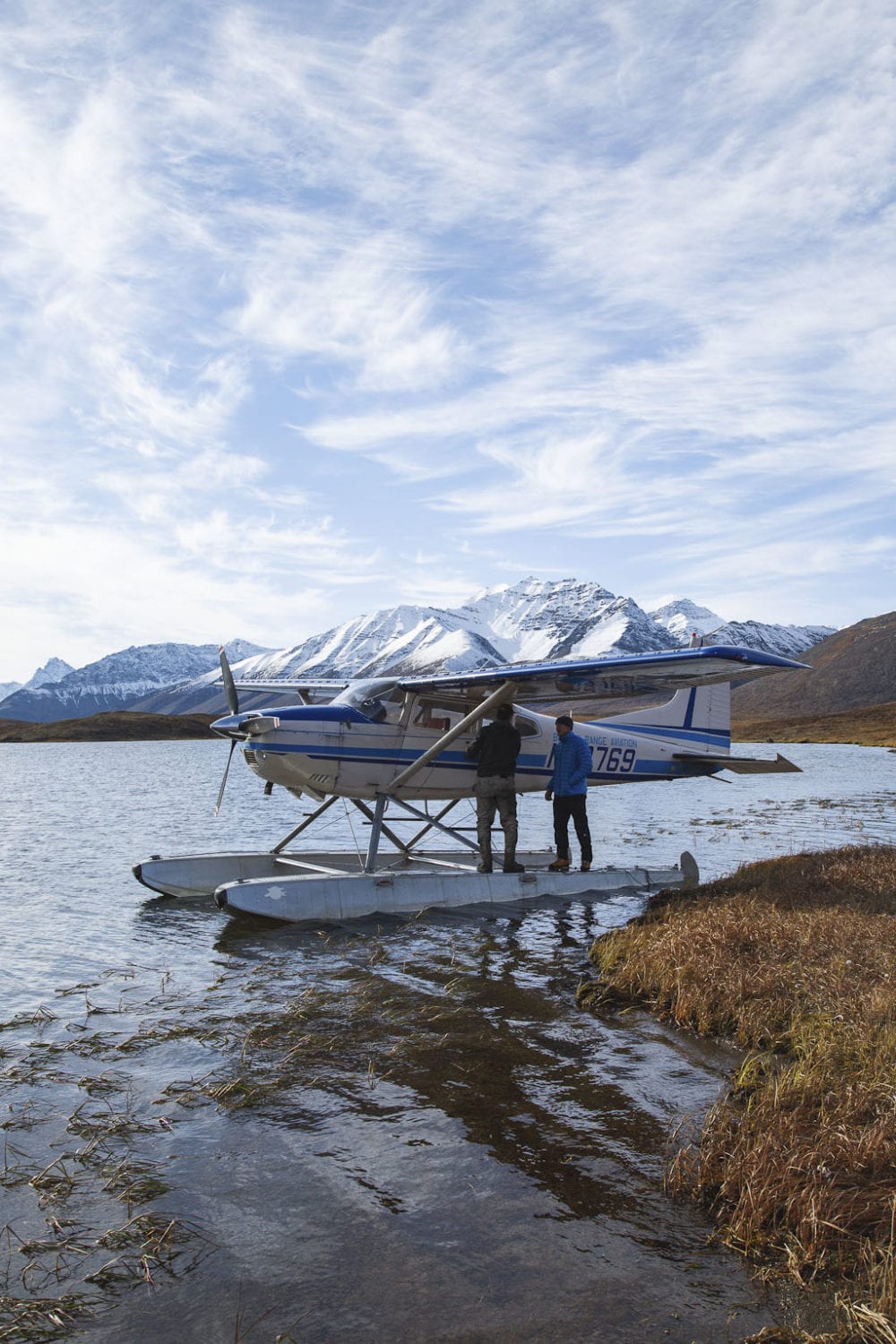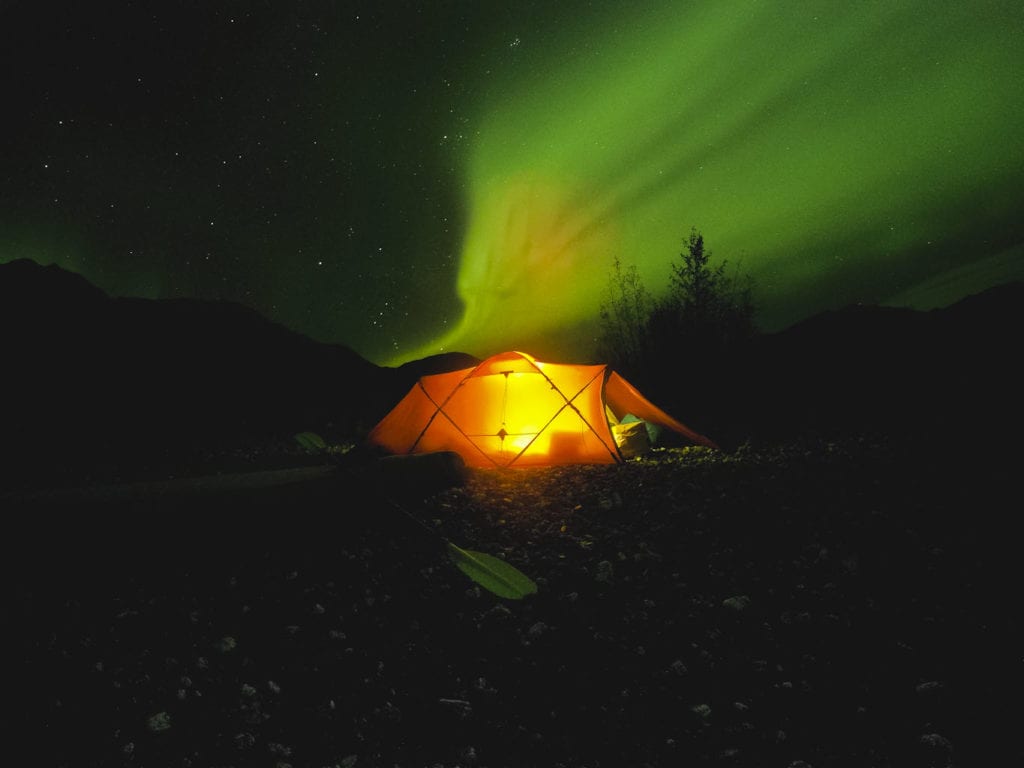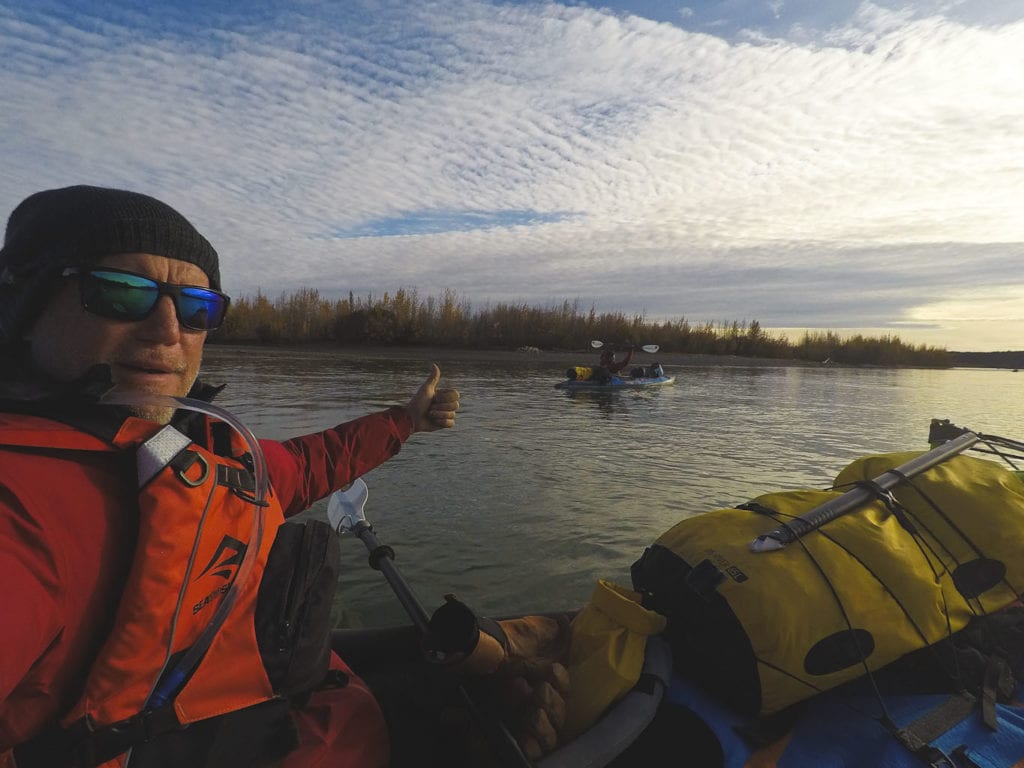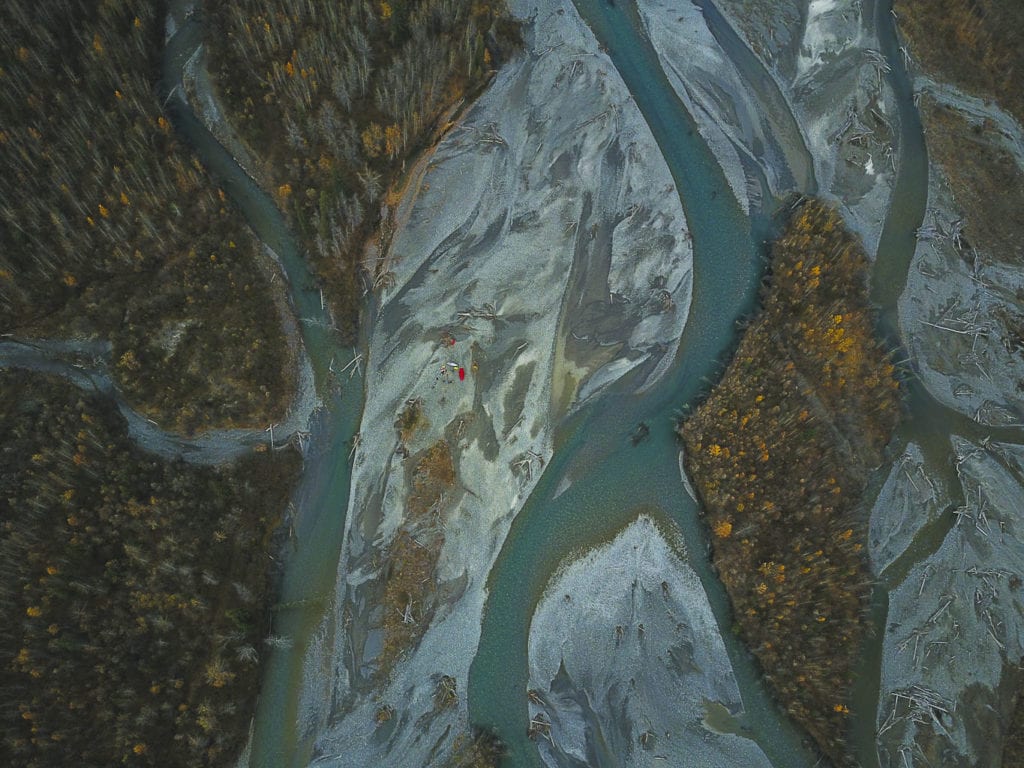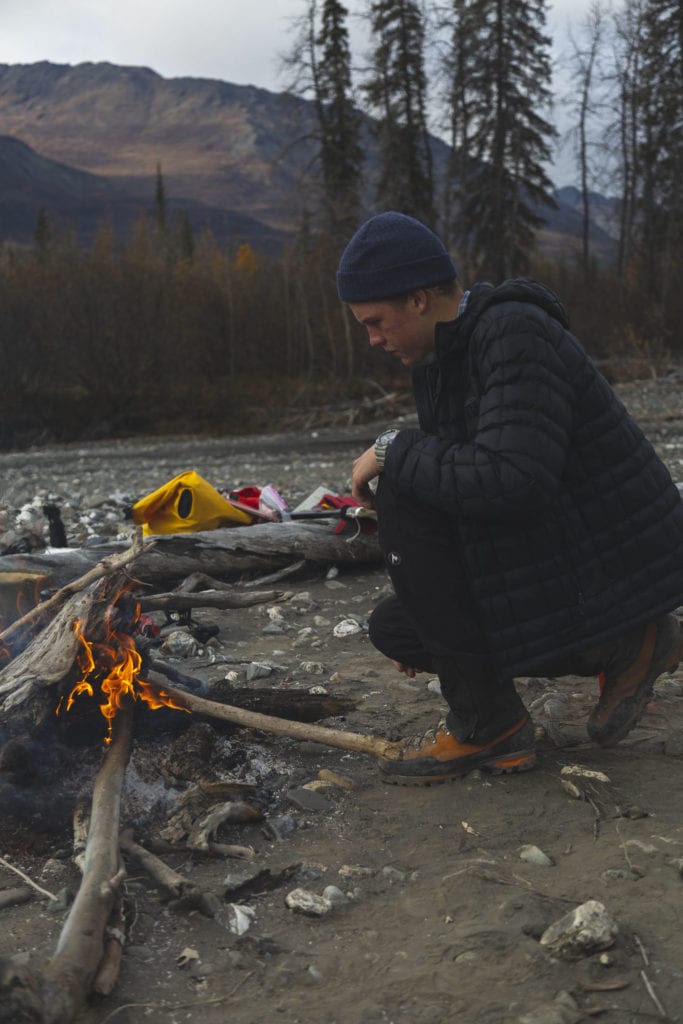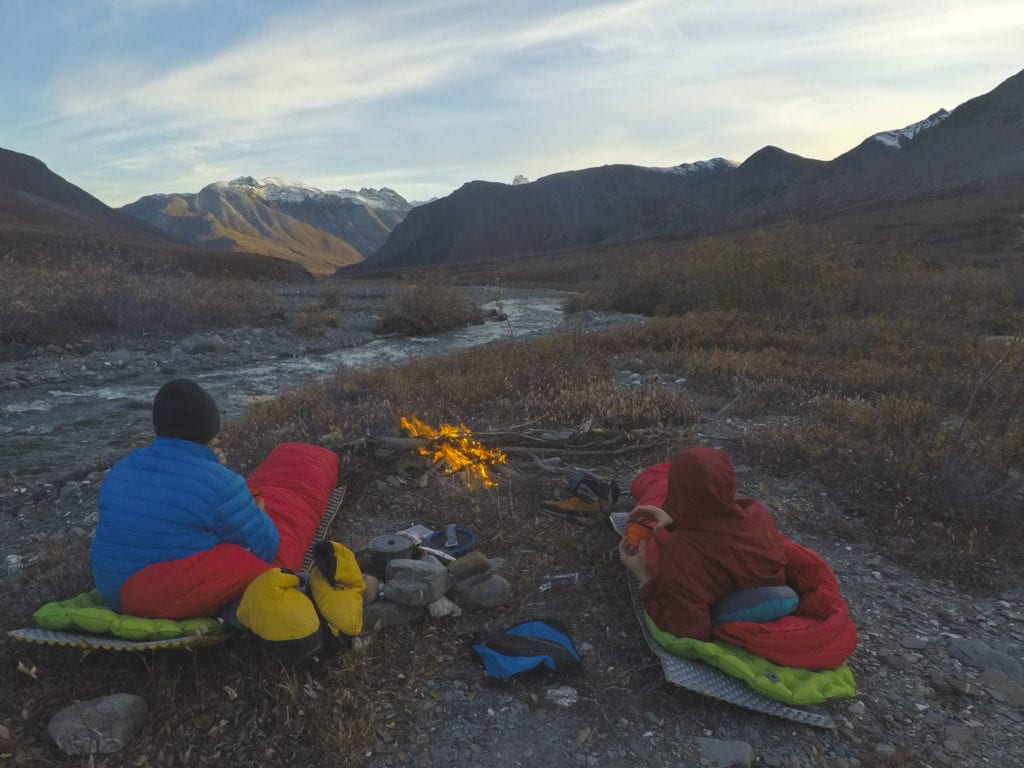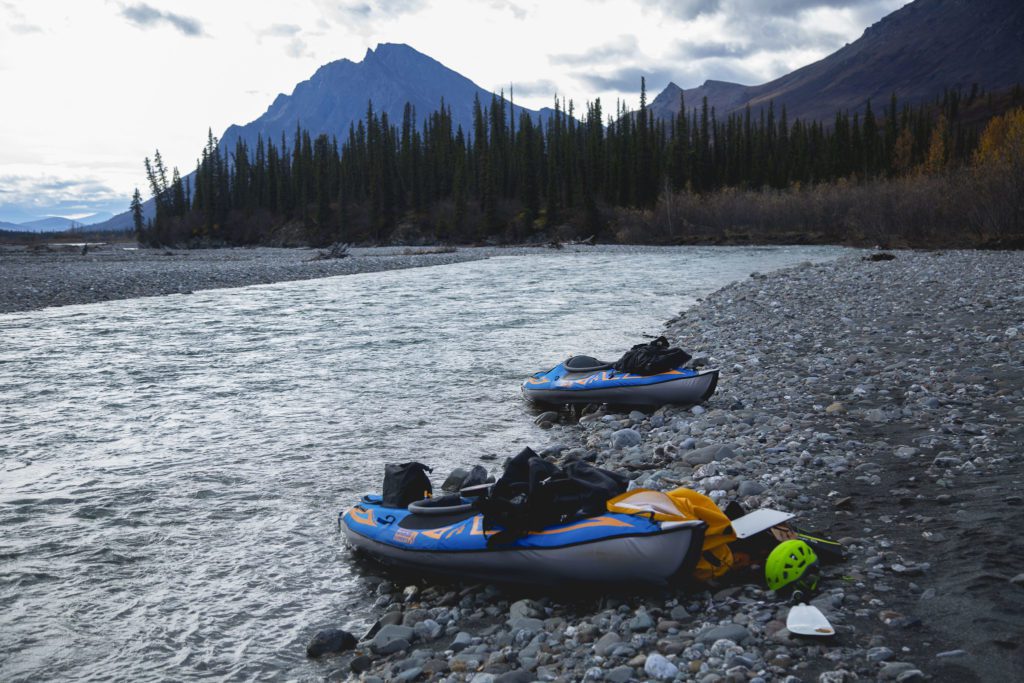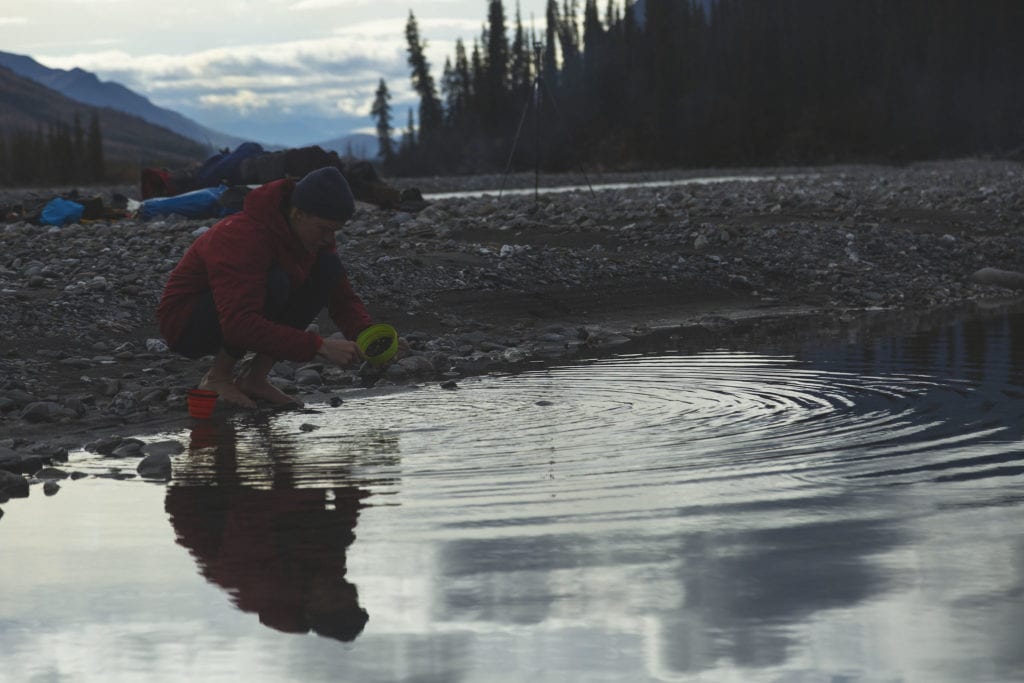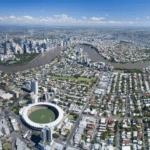TRAVEL
Gates of the Arctic
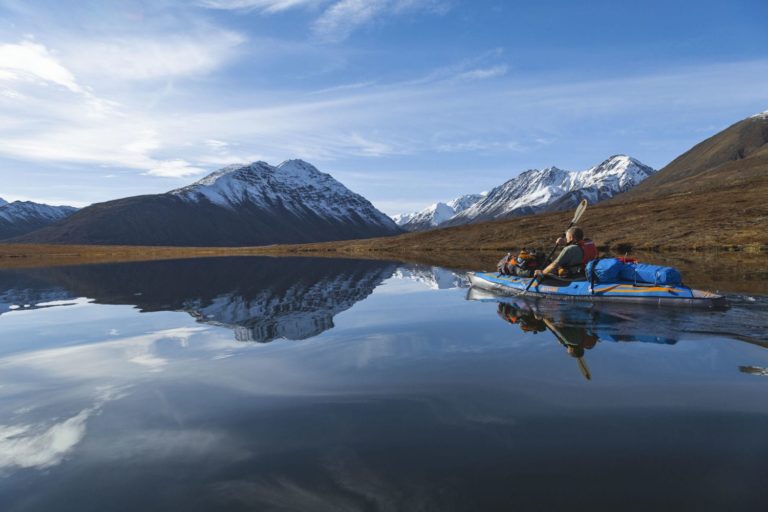
WORDS: Geoff Wilson PHOTOGRAPHY Kit Wilson
In a small farm in a leafy suburb called Currumbin, a father and son dreamed up the ultimate adventure to cap off his gap year…
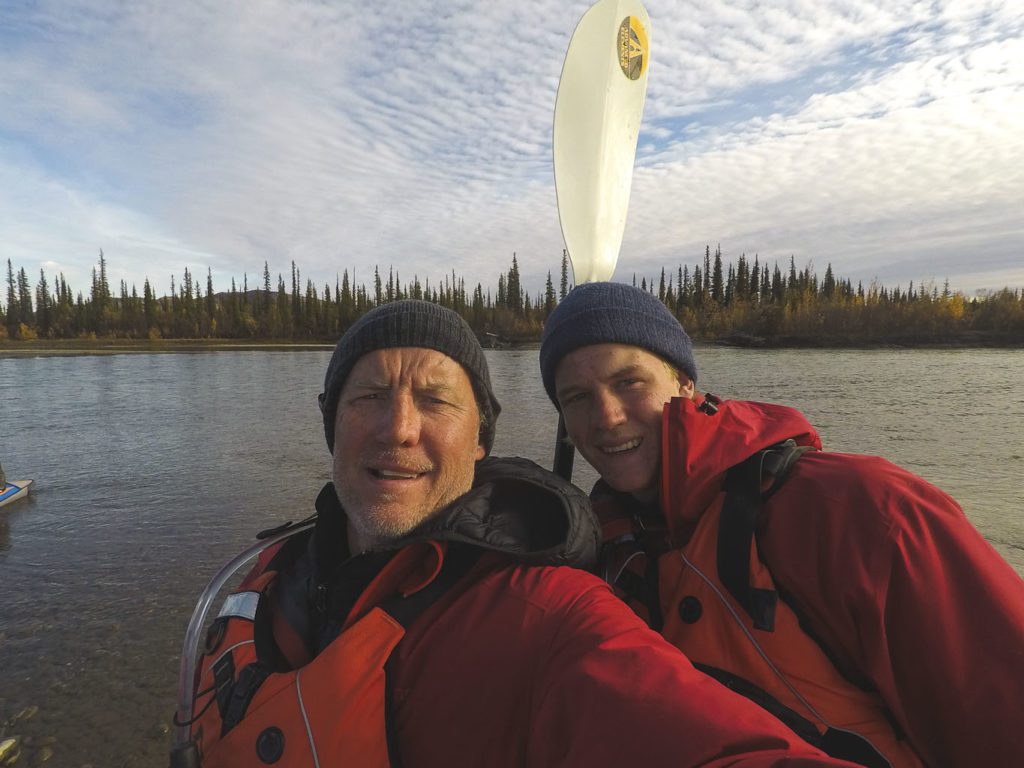
Geoff & Kit Wilson
The paddle dipped silently into the freezing autumn meltwater rushing southwards off the Brooks Range that surrounded us. The kayak glided effortlessly forward, with each paddle we inched closer to home. The autumn gold and ochre colour tones made the harsh Alaskan wilderness seem somehow more gentle. Golden leaves pulled by frosty Katabatic winds coming of the steppe behind us warned of the winter coming quick on our heels. My son Kit and I carefully navigated the dangerous waters as we used its raw energy to carry us southwards from our latitude well above the Arctic Circle.
The eddy caught the bow of the kayak as fast water entered a deep bend in the river and slowed to walking pace. Movement caught my eye on the right bank and there he was in all his wild majesty. The sheer mass of him took my breath away, sitting on his haunches this huge male Alaskan Grizzly Bear was at least 8 feet above the gravel he sat on 20 meters from the shoreline, a mere 25 metres from me, with Kit a kayak length behind me.
So many miles portaging streams to small to kayak, impassable rapids, gorges with falls so steep no man could pass by them, on these treks enormous intimidating bear spoor became commonplace. Scat oozing fresh purple berry juice an oddity we soon grew used to. All the while I was dreading the inevitable on-land encounter and now here we were. I turned the nose of the kayak to face him and held position about 6 metres off the bank whispering to Kit “Bear mate, Bear…”
The Grizz watched us intently but continued to feed on berries sitting like an enormous comical rabbit, however his dark eyes never moved off me, his gaze focused with an intensity that made me instantly uncomfortable and aware of his raw wild nature. It was all calm, but suddenly our situation deteriorated with a speed that allowed no time for correction or change in fortune or circumstance.
In an instant, this alert nibbling bear morphed into a ferocious and terrifying predator, dropping to all fours he charged with an energy and speed that shocked us both. I recognised the immediate change in our futures and milliseconds slowed and bent as the huge bear bore down on us. His powerful forearms driving his 400-kg frame towards the river, gravel flying as his bulk dissipated power into the very earth under him.
My hope that the river might save us the violence to come vaporised as his chest surged into the frigid waters with no pause, his right arm taking a big stroke drawing him ever closer to my weak position perched on an inflatable kayak. The encounter that we’d dreamt of talked of and hoped we’d never experience was here now upon us in all its malice and fury. In every journey, one plays the risks over and over in one’s mind pre-expedition, not actually ever expecting to meet the imagined fate. However, in this moment an end without pain, mutilation and even death now seemed unlikely.
How did we get here? How had I put my precious son in harm’s way like this? What decisions would I change given another chance at life? So many crevassed miles crossed, dry minefield laden deserts, isolations beyond description, a myriad of high-risk ventures and this was how it was to end…
Our home base for all our worldwide expeditions be they polar, desert or mountain is a small farm in a green leafy valley called Currumbin on the east coast of Australia. It is here in our adventure office surrounded by maps and river guides that my son Kit and I dreamt up the ultimate Father and Son adventure to cap off his amazing gap year. The gap year that had so far taken him to the furthest reaches of the New Zealand Alps, remote Indonesia and now Alaska. Passionate about reminding Ozzie Dad’s to take time to adventure with their kids we planned to make a short film of our attempt to traverse the Brooks Range the very spine of Alaska’s wilderness to showcase the message and tell a good story.
Two full days of rigorous travel and 7 flights from home saw us at our last point of civilisation, the small town of Bettles population 12, well north of the Arctic Circle. Loading our inflatable kayaks, tent, survival gear, food, fuel, climbing gear and film equipment into the float plane I marvelled that it even took off. Once airborne we banked left and headed towards the continental divide, the very spine of Alaska and the start of our journey, our destination Summit Lake, Central Brooks Range.
As the aircraft deposited us, departed, banked and turned south towards Bettles silence settled over the magical Oolah Valley once more, reminding us of our mere insignificance out here and of the enormous challenge we’d set ourselves. The Gates of the Arctic National Park is 8.4 million acres of totally untouched and unspoilt Alaskan wilderness protected largely by its complete isolation. Its beauty is breathtaking, a myriad of snow-covered peaks, meandering rivers and ice-encrusted tundra. However its beauty masks a malevolent heart, it is a “black belt” wild space that can turn quickly and punish a mistake with rapidity. Our exit and extraction point was more than 250 km of tundra, mountain peaks, melting snow and winding river valley away.
The huge winter snows of Christmas 17/18 had created thunderous meltwaters and warnings came from many sides. Alaskans advising extreme caution regards the rivers, the predatory bears, the killer mosquitoes, raging rapids and all manner of terrible deaths to be had in the interior.
Pushing all fears aside we inflated our Advanced Element Kayaks and stowed our gear in high spirits as we entered the Summit Lake’s dark waters. Our expedition plan was to cover the approximately 50 km of winding river and valley to the base of Mount Doonerak in two hard days. Then to scale and summit the lofty peaks of Mount Doonerak (often called the K2 of the Koyukuk range) in 3 or 4 days, and finally to cover the final 200 km of river to Bettles our extraction point in less than a week.
With kayaks, 30 kg of climbing kit each, food, fuel, solar power system, batteries and film gear each of us was responsible for close to 90 kg of equipment each. Way too much to move without the assistance of the river, we were totally reliant on our Kayak’s to get us to the mountain and then home.
Our first hurdle presented itself immediately as we kayaked to the Southern end of Summit Lake. The drainage from the lake was less than a foot wide, simply oozing into the defrosting tundra. Kit and I began to portage gear southwards, staggering through an incredibly complex mess of rivulets, bog, marsh and tussocks of almost impassable grass interspersed with thick oil tinged stinking mud. Hordes of insects getting disturbed with each and every step even if it appeared not all seemed that interested in sucking your blood.
At days end we’d paddled three lakes, dragged through innumerable bogs and finally entered a river system called the North Fork of the Koyukuk River, a mere hands width deep and tortuously complicated and confused as to what direction it would take south. However, with Marmot Gore-tex pants and good old Aussie surfing booties on we were able to drag the Kayaks loaded within the creek and made good ground towards the day’s end.
Physically done in by 9 pm, we made camp on a gravel pan next to a now formidable river, a foot deep and 15 feet wide. Our straight-line distance from our drop off point as a mere 3.7 km however we’d trekked close to 25 km through near impassable terrain to get to camp 1. Unless things improved we’d be out of food before we made it out of the intractable swamp.
Day 2 saw us begin the day fatigued and not acclimatised to the altitude or terrain, this may excuse the rookie errors we made this day. We made mistakes that nearly ended our expedition before it had really begun. The river alternated madly from harsh gravel pans covered with foaming shallow rapids just a few inches deep to fast-moving narrows winding in and out of fields of tussock grass oozing black fluid into the watery world we found ourselves stuck within. We discovered that it was within the transitions between each river type where the danger lay and it was here that disaster struck. The freezing run off bit into any exposed flesh immediately and despite booties, our feet screamed for mercy after just 15 minutes immersion as we dragged our kayaks through the shallows. In the deeper waters, we could get into the nimble kayaks and made good progress with relative ease.
I had just skirted a difficult transition from shallows to deep water and turned to warn Kit of a particularly aggressive rock when I saw him pitched sideways and face forward into the black meltwater. Feet trapped within the kayak loaded heavily and bravely refusing to submit kayak or paddle to the pull of the river he ran the risk of drowning in just 2 feet of water. In the mad panic to assist him, I managed to flip my kayak in unison and realised with horror that I had not secured the Sat phone in a Sea to Summit dry bag. A period of chaos ensued whilst we got kayaks, gear, paddles and bodies onto the gravel bank. Hands shivering and bodies fast succumbing to early signs of hypothermia, we struggled to get a fire going. Stripping Kit we sourced dry clothes and huddled close to the flames.
Starting the MSR stove I franticly checked the phone bag to find it floating in an inch of water. With no communication, our journey would be all but over, in desperation I pulled the phone apart and began to dry it over the stove. A groan and some expletives from my expedition partner followed as Kit found that the main camera the Canon 5D MkIII digital SLR had also suffered water damage. Ill-prepared for the sudden shift from creek to bona fide river we’d been caught short like a pair of rookies, now losing our primary tool for recording the adventure and our only way of communicating with the outside world excepting via total emergency evacuation initiated by our PLB’s (personal locator beacons).
Unable to get either piece of equipment working we buried them in a STS Dry Bag packed with couscous and prayed for a miracle. Once dry we packed with more caution and got underway having lost half the morning needlessly and at extreme cost in terms of safety and expedition goals. We both could now hear the killer gorge up ahead and inched forward with rising trepidation not wanting to get sucked into the dark abyss with its now mad falls and inescapable walls.
Early that afternoon we pulled over onto the left-hand bank, and by recceing forward realised that it was the end of the easy mileage as the river became unmanageable then maniacal as it entered a deep cleft that seemed bottomless from above, dropping over 2,500 feet within a few short kilometres. Splitting our equipment into two loads we humped forward a difficult 4.8 km past ominous Caribou skeletal remains being reclaimed by the tundra, up and over numerous wet ridges.
Returning for load 2 we staggered forward then finally almost at a point of exhaustion returned for a third-time and man-hauled our kayaks, dragging over swamp, tussock and rock almost beyond caring if they were tough enough for the punishment the terrain was metering out in spades. Forcing us to cover 25-km to make just 4.8 km in the direction of home. Camp 2 was a stone’s throw from the escarpment drop off, we set the tent and collapsed, aware of the precariousness of our situation and humbled by the way we’d been dominated by Alaska that day. Before turning in, I spent some time scanning aerial photographs of the gorge and escarpment to try and determine a safe way down. Not entirely sure that the shale covered loose cliffs would allow us to exit at all I eventually drifted into an unsettled sleep.
Kit rose early with me and we jammed swollen bruised feet into our boots then explored the nearby cliff edges, eventually finding a narrow Caribou trail that promised a possible descent to the valley floor 2,500 feet below. Packing camp we once again split loaded our ridiculous amount of gear forward in three stages. Unable to get any protection (cams or nuts) to hold in the splitting slate cliff we free down climbed unprotected, sometimes scrambling and sometimes sliding on our backsides scree and shale falling all around us.
At other times we followed switchbacks and paths made by generations of herbivores following instinctive migrations up these ludicrous walls of loose stone. A 10-hour day followed, filled with risk of cliff slide, falls, broken ankles and eventually once we made the valley floor a heavy bear presence evidenced by spoor, scat and bear diggings. Having climbed the cliff three times and having traversed at least 7,500 vertical feet loaded with up to 30 kg each climb we sat for a while looking upwards marvelling at what we had achieved.
Pushing forward for another kilometre along the valley floor we set Camp at the confluence of Alinement Creek and the North fork of the Koyukuk. It seemed each creek argued for dominance creating a relative maelstrom of sound and foaming waters well beyond our abilities to safely kayak. The mood in the tent was dark as Kit cooked and I tried to regain some control of our situation, couscous STS dry bag open trying to resurrect the SLR and Sat phone.
A glimmer of hope came as the digital array came to life on the Canon, but the Iridium phone remained completely dead. Before bed we discussed rescue and both agreed that we had never ever required extraction from any wilderness prior and despite the tough run of luck we were in, we’d grow character and press on metre by metre until we got home. We did both agree that without a satellite phone and on rock presumably similar to the killer wall we’d encountered this day, Mount Doonerak quite likely would not be safe to climb.
The sun rose hours before its light entered the deep cold valley in which we were encamped. I had stared at the river for hours weighing up the risks of entering it with my son. It seemed ominous and angry, unwelcoming, foreboding. I knew that unless we gained some easy miles we’d be at risk of not making it out before provisions ran out, but was it worth risking it all for some easy miles.
After breakfast, I decided we’d hump the electrics forward, scope each and every rapid and then try to run them with 2/3s of our load. Another 5-km scoping the river followed in which we were forced to take our boots off and wade waist-deep into the raging waters to cross at least 10 times, eventually entering the valley that ran directly in front of the majestic mountain we were here to climb.
The upper snow-covered reaches peeked through wet mists as if spying on us as we cached our electric and camera gear on the riverbank.
The entire walk back I questioned what we were about to undertake. Was I putting my boy in needless danger, was this inspired adventure or sheer madness? Finally reaching the Kayaks, we pumped them up firmly, secured the dry bags and entered the water without much said. Immediately racing southwards, we soon made easy miles interlaced with sheer rushes of adrenalin as we marvelled at how well the Kayaks handled the rapid changes of direction needed to manage the class and 3 and 4 rapids. Growing in confidence we hooted each other as we ran the rapids and tolerated the occasional soaking and eviction. Hanging on dearly to paddle and kayak, each entry into the river risked hypothermia, however, the continual movement required to manage the 5 km to our gear cache warded the chill off enough to make camp at the base of Mount Doonerak.
The river narrowed here and the gravel pan was thin and we were forced to make a vulnerable camp close to the river’s edge. A slight drizzle splattered us as we set the tent, a small mental caution warning light came on in my brain, if real rain started we’d have to try and seek higher ground during the night.
That evening in pure frustration I decided to take the Sat phone apart and by some miracle managed to get it to reawaken and even to link to a satellite. Only 50 per cent of the buttons pressed worked but as Sarah’s number was in memory I was able to make contact with her. The venom unleashed from Australia left me in no doubt that she was upset re our carelessness, putting her precious son in harm’s way, leaving her in the dark as to our state for so long. Despite knowing that we had not set off our emergency beacons she was justifiably upset that we had not had any communication for several days now.
Once calmed, I was able to explain our situation and she made just one demand. That demand was that unless the phone was entirely reliable, that we not climb the dark peak directly above our little tent at all, but pass it by. After the call Kit and I sat outside our feet warming by the fire, staring up at one of the most beautiful, but also most foreboding mountains I have ever seen. It mocked us, called us, taunted us and asked us to cross that “thin white line”.
The line that represents good decisions in the wild places, that line that once crossed makes safe return home less likely. The dark stone it seemed to me begged we try chance, asked that we climb regardless of chossy, flaky stone, regardless of our exhaustion, regardless of poor comms, ignore the wifely wisdom and climb tomorrow. Not entirely sure I’d obey my wise wife, I curled into my favourite sleeping bag and let the goose down calm my troubled mind as I dreamt of lofty heights bound in deep unstable snow.
The stove roaring woke me and I saw Kit dressed outside preparing breakfast, he was wearing Marmot Gore-Tex pants we’d found invaluable on the river and on his feet booties not Scarpa approach boots. He had made his mind up. Kit is a great blend of Sarah’s wisdom, intuition and innate common sense, he has my wild nature but is a whole lot less inclined to make mistakes than his Dad. With a degree of heartsick sadness, I looked upwards at the tip of Mount Doonerak as it poked through the wisps of cloud and agreed my son was correct. We were lucky to be alive this far, the approach had been brutal and our gear not sufficient for a safe climb on flaky rock that had proved impossible to protect against death by falling. Besides this, we had no way to communicate reliably with support in Bettles or home. The best course today was to humbly accept defeat, promise to come back better prepared and live to climb another day. With few words communicated, we ate and broke camp. Hoping against hope to exit the rapids today, and make the calmer waters near the Gates of the Arctic, the phenomenal rock gorge between two vast mountains that give the region its grand name.
The river seemed intent to punish us again. The first serious rapid tipped me in, clasping the kayak I smashed over a car-sized rock and then made for the bank. Draining the kayak, I reset myself, cursed and watched Kit expertly negotiate the rapid that had just chilled me to the bone.
Dry for less than half an hour, it promised to be another long day. Rounding the next corner I squeezed madly between a field of large rocks with turbulent overfalls and eddy’s making life very difficult. Just making it through I instinctively headed for the left bank, hauled the kayak up onto the gravel and yelled a warning too late for Kit. Kit’s kayak was pitched sideways up onto the worst rock feature in the overfall, driven upwards and outwards he held onto paddle and kayak but the sheer force of water entering the seat of the kayak tore it away downstream.
Recognising the danger of our situation Kit yelled out and without hesitation I leapt into the river fully committed to reaching the kayak as it ripped downstream on its side. I picked a course bouncing like a human crash test dummy through the rapids, got lucky and got a hand on the kayak. Dragging it to the shore, I counted dry bags and realised by a miracle we had lost no gear.
My joy was stripped quickly away when I turned and saw Kit’s face. He staggered along the bank to where now both Kayaks lay, his entire visage a picture of brokenness and fatigue. The river was frightening and we were operating right at the edge of our abilities trying to make way through the mad waters. Kit recognised we had narrowly escaped losing vital survival gear and in reality, we’re in a position where we had had too many narrow escapes in a short period for it to be sustainable without disaster. A real survival situation had been averted by a mere whisker. The frustration at not climbing, the wildness of the place and the sheer physicality of the travel had worn him down and I could see he wished to be gone from the darkness of Oolah Valley.
Letting him calm, then dealing with the imminent hypothermia we unpacked his desperation and eventually agreed we had no option but to press on as safely as possible, there simply was no other way home. Approaching each rapid with caution, one us of us would go through the difficult section, make the bank and call the second kayaker through. In this manner we progressed slowly and by 4pm we’d entered a wider river where the Ernie and Kachwona creeks entered the valley from the north and west. We could see the most incredible rock feature, the Gates of the Arctic to our south now.
Boreal Mountain loomed above us to our left and Frigid Crags to our right as we pulled over to the bank for the last time that day and made Camp 5 in as picturesque a position as any camp I have ever seen. Since nearly losing Kit’s craft we had both managed to stay dry for the entire remainder of the day, this with the widening and calming of the watercourse lifted our morale. However, Mount Doonerak’s savage peak still visible just over the northern horizon, in my mind mocking us as we set up the tent.
Day six was heralded by a phenomenal blood-red dawn, high clouds skipping over Boreal mountain tinged with gold and the last of the snows as we had dropped significant altitude the previous day. Pressing ever southwards we were able for the first time to really enjoy the beauty around us as each meander of the river opened up a new vista of forest, mountain and tundra. The mountains soon began to give way to rolling brown hills as we began to make the southern reaches of the Brooks Range. The rapids now few and far between, the “sweepers” or buried trees our only significant river-borne danger in this part of the wilderness.
Rounding a calm meander, there he was, the Grizzly. Having endured so many challenges, having negotiated obstacles that would break many a man, having made good decisions to correct our bad ones, it seemed Alaska did not want us home at all. He charged.
The bear’s rush had caught us totally by surprise, we made no evasive action nor had time to reach the flare gun or bear spray to halt his charge. The bow wave from the bear’s mad entry into the river washed under my bow and made me unstable. I stabilised the kayak with the paddle as the Bear made a stroke towards me then inexplicably stopped a mere 5 metres away. A huge exhale of breath signalling the end of his charge, his menacing eyes engaged mine and I looked down not wanting to challenge him further.
Lifting the paddle out of the water, both Kit and I let the current take us into deeper water then downstream. The bear sat and watched us then climbed the bank in an odd sideways shuffle, showing us his huge shoulder. Unsure if he’d follow we floated backwards eventually out of line of sight, then turned and paddled at speed to the south and out of harm’s way.
Paddling quietly, we were both intensely aware that a miracle had once again spared us. We felt that aristocrat of all emotions, gratitude, surge through our veins, washing away all disappointments, salving any pain in joints, backs and bodies. Despite this positive mindset, both of us had night terrors that night, waking in the tent with images of limbs torn apart, teeth-gnashing and crunching bone bringing us out of slumber. Why had he stopped his charge when so obviously committed to entering the river and even swimming some way towards me, had our angels once again stepped in?
Occasionally in life, we get a second chance, this felt like one of those times. The Bear’s malice had been so palpable, his intent so clear, there was no way of seeing this any other way.
The next few days saw us make good daily distance, the little settlement of Bettles creeping slowly closer. Having had no human contact for so many miles the purity of our environment slowly ebbed away, first a human footprint on the bank, then a hunter in the distance, and finally a light aircraft overhead and almost in a rush, like the ending of a great novel the journey was over.
We had made it across the Brook’s range, covered 250 km of river through extremely difficult terrain, we had had several genuine survival situations, communicated well and worked well as a team. As father and son, we embraced on the bank, a humble gravel pan facing a log cabin dilapidated and falling into the river marking the end of our trek.
As a father huge relief washed over me, my son was safe, but not only that, he had shown incredible strength and character under duress and I had watched him grow, watched him prevail through conditions I knew would have broken lesser men. Alaska has passaged both of us towards making better men, appreciating life more, loving our special ones more and thanking our maker for all the miracles we’d seen within the mighty Brook’s range, one of the last raw wildernesses left.


